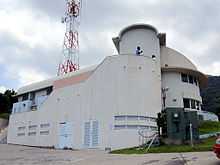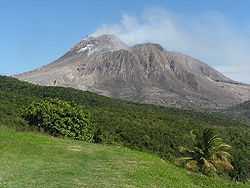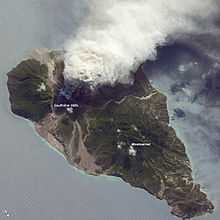Montserrat Volcano Observatory



The Montserrat Volcano Observatory (MVO) is a volcano observatory which is located on the Caribbean island of Montserrat, where the Soufrière Hills volcano (SHV) has been actively erupting since 1995.
The MVO staff describe their activities as working to reduce the impact of volcanic activity by monitoring, researching, educating, and advising.
The MVO building is situated in the village of Flemmings, in the parish of St. Peter, in the northern part of the island.
Reaction to the 1995 outbreaks
The volcanologists monitoring and researching the volcanic activities on Montserrat came under immense political pressure to provide suitable advice after the first outbreak.[1] The eruptions have been deemed a classical example of the black swan problem[2] as a high-profile, hard-to-predict, and rare event which provided major challenges for the prediction of further developments. Till 1995, the volcano had been silent for centuries. After some difficulties, the involved scientists began to use statistical models to estimate the probabilities of particular events, a rather subjective method, but suitable to built up experience-based expertise (including local knowledge and experience) step by step.[1] A 2012 study about knowledge generation and expert advice on active volcanoes used the Montserrat eruption as a showcase, but included as well interviews with scientists in the United Kingdom, Montserrat, Italy and Iceland during fieldwork seasons.[1] It listed the Montserrat case among other recent and historical eruptions that had an influence on volcanology as a science.[1]
See also
| Wikimedia Commons has media related to Soufrière Hills. |
- List of volcanoes in Montserrat
- National Geographic Seconds From Disaster episode, aired March 7 2007
- List of settlements abandoned after the 1997 Soufrière Hills eruption
References
- ↑ 1.0 1.1 1.2 1.3 Amy Donovan, Clive Oppenheimer, Michael Bravo. Social studies of volcanology: knowledge generation and expert advice on active volcanoes. Bulletin of Volcanology, Springer Verlag (Germany), 2012, 74 (3), pp.677-689. doi:<10.1007/s00445-011-0547-z insu-00691620
- ↑ Donovan et al. (2012) cite Taleb NN (2007) The black swan: the impact of the highly improbable. Allen Lane, London
External links
- Official website
- Official Montserrat Government page about MVO
- MVO's live webcam view of the volcano
- A more technical account of the volcano's activity
- Site written by a retired earth scientist about the Montserrat volcano
- A view of the 2003 MVO building
Coordinates: 16°44′55″N 62°12′46″W / 16.748686°N 62.212784°W